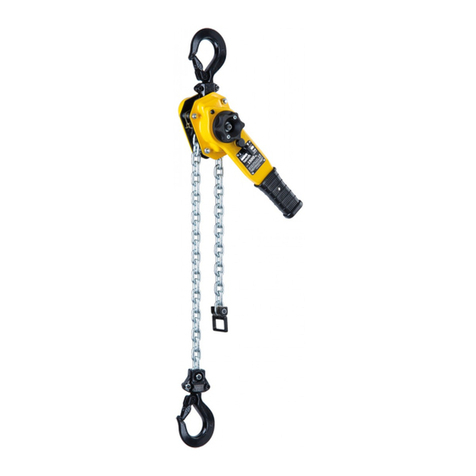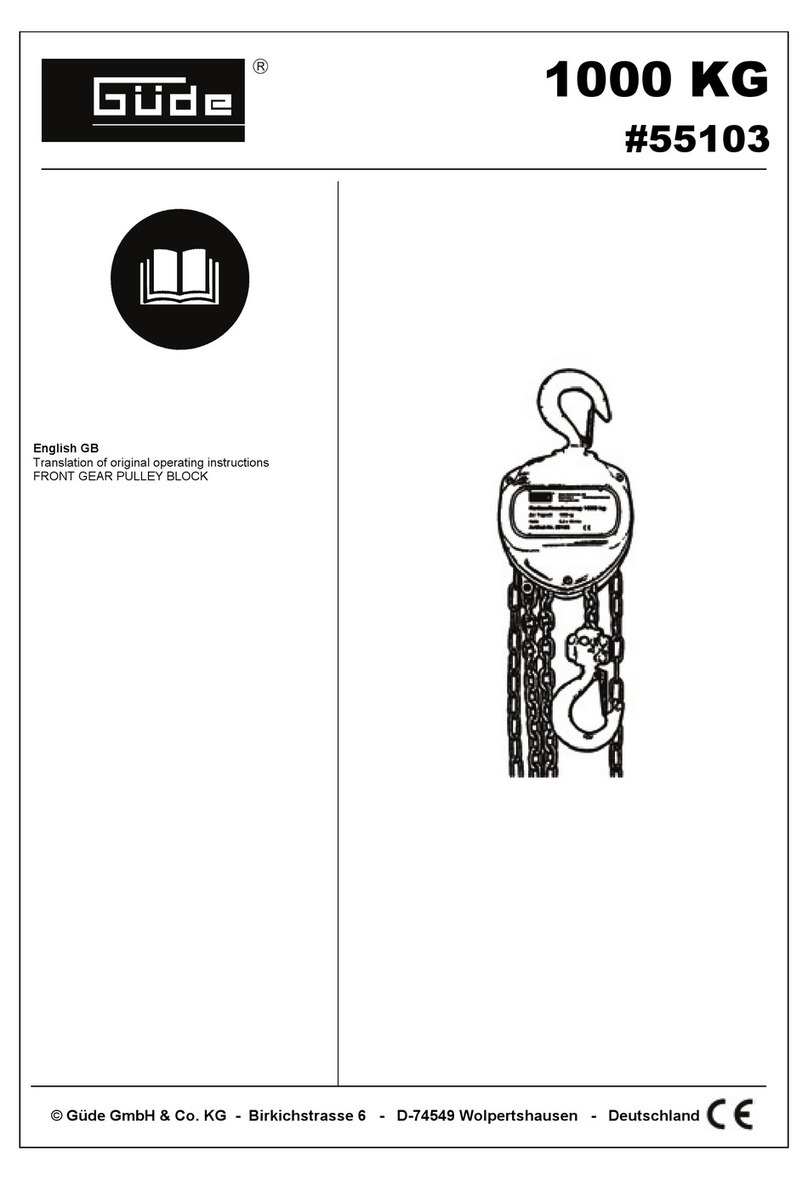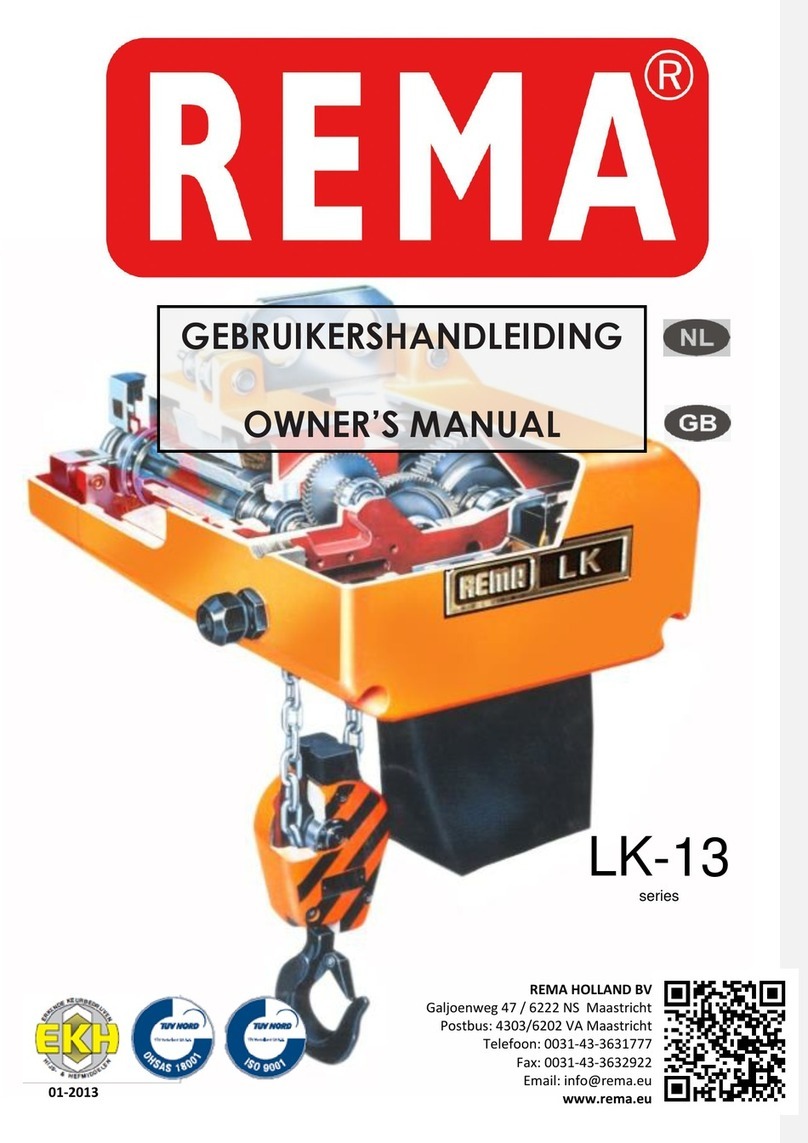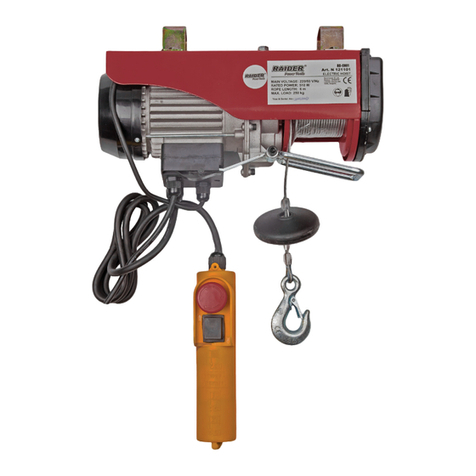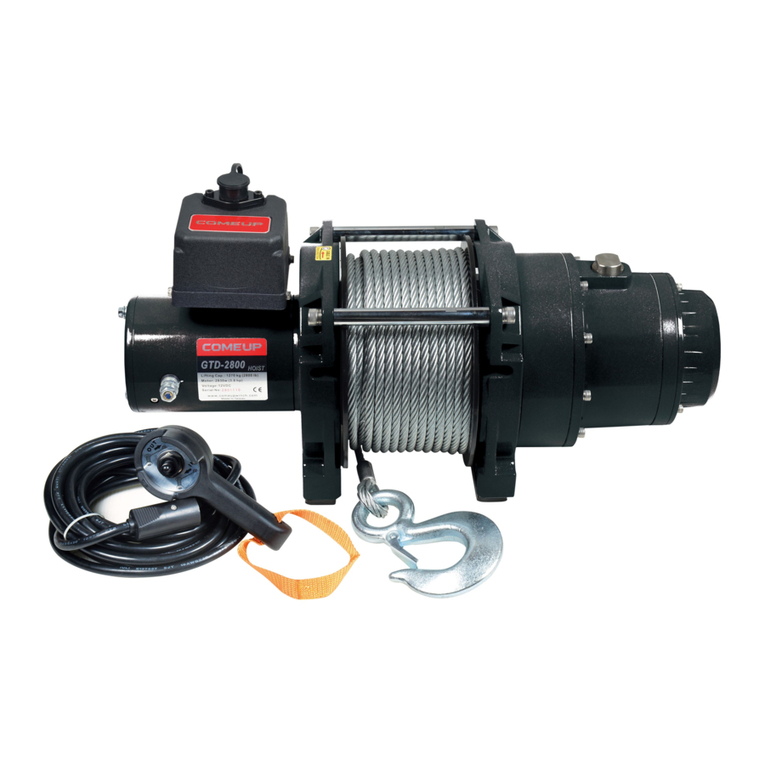Elephant YA-80 User manual

●
This manual should be surely handed over to the users.
●
The users of the chain lever hoist should thoroughly read this manual.
No.1
●
Thank you for your purchasing of our product (YA series).
●
It is quite important that you carefully read this operation manual before using
the chain lever hoist.
●
This manual should be kept close to the chain lever hoist, as the maintenance
and inspection works absolutely require it.
●
Please consult distributors of our firm's products about the inspection requiring
dismantling and assembling of the unit.
CHAIN LEVER HOIST
MODEL YA-80,YA-100,YA-160
YA-320,YA-630,YA-900
(ONE TOUCH FREE SPOOLING MECHANISM)
OPERATION MANUAL
ELEPHANT CHAIN BLOCK CO., LTD.
Elephant Lifting Products | http://www.elephantlifting.com

1
SAFE OPERATING PRACTICES
Improper operation of the chain lever hoist will possibly cause dangerous
situation such as falling of lifted loads, electric shock and so on. Carefully read
this manual for proper operation before setting-up, installation, operation,
maintenance and inspection of the chain lever hoist.
Do not begin to operate it before you have got familiar with its knowledge,
safety information and all the special cares.
The cautions in handling the unit are classified into two levels in this manual;
This symbol is used to indicate that a death or serious
injuries will be caused in all probability to the user or persons
around when the products are improperly used.
This symbol is used to indicate that damage may be
caused to the user or persons around or only material
loss will occur when the products are improperly used.
Even the matters indicated “ “ may bring a serious result depending on the
situation. Strictly observe both the notices as they contain very important matters.
Examples of the symbol:
△
mark indicates that there are warning/cautious matters. In a sketch a concrete
warning (“caution for falling of lifted loads” in case of the symbol
on the left) is described.
mark indicates actions to be prohibited, in a sketch or nearby a concrete
warning is described.
mark indicates that any action will be required or directed. In a sketch
a concrete warning (“general duties for the operator” in the case of the symbol on
the left) is described.
※
The manual must be kept in place where the operator can read it whenever he needs.
1. General
● The unit should be operated only by those who are familiar with the
manual and contents of the instructing labels.
● Never lift a load which exceeds the rated load.
● Do not stay under a suspended load. Do not operate the chain lever hoist
when somebody stays in an area where a suspended load is moved. Do not
move a load over persons.
● Do not use a chain lever hoist which was damaged or causes abnormal sound
and/or vibration.
● Do not use a chain lever hoist with twisted, kinked, damaged, severely worn,
deformed, or elongated load chains.
● Never manipulate the operation handle by connecting a pipe and the like to it
or by foot.
● Never make modifications to the chain lever hoist and its accessories.
WARNING
CAUTION
WARNING
Elephant Lifting Products | http://www.elephantlifting.com

2
2. Installation and Setting-up
●
Inspection before operation and periodic inspection must be by all means
carried out.
●
The installation work should be performed only by the specialized
contractors or experienced technicians.
●
Make sure that a location on which the chain lever hoist is installed has a
sufficient strength.
●
Fix loads firmly on the bed of truck by the chain lever hoist and observe the
relating laws and regulations in your country on driving along a load.
●
The chain lever hoist should not be installed in places deviated from
the provision where it is, for example, exposed to rain or water.
3. Operation and Handling
● Do not get on a suspended load and do not use the chain lever hoist
to lift, support or transport persons.
● Do not allow your attention to be diverted from operating the chain lever
hoist.
● Do not use the chain lever hoist for the earth lifting (for example, lifting objects
fixed under the ground).
● Turnover of a suspended load should be done only by the experienced operator.
● Make sure before operation that the lever properly functions. Do not operate
the chain lever hoist when the lever is in disorder.
● Make sure before operating the chain lever hoist that the brake properly functions.
Do not operate the chain lever hoist when the brake is in disorder.
● Do not make electric welding on a suspended load.
● Do not allow the load chain to be used as a ground for welding.
● Do not allow the load chain to be touched by a live welding electrode.
WARNING
CAUTION
WARNING
Elephant Lifting Products | http://www.elephantlifting.com

3
●
Do not use the chain lever hoist with a damaged safety latch of the hook.
●
Do not use the chain lever hoist with name plates and labels attached
to the body removed or left unclear.
●
Operate the chain lever hoist only by means of a manual pulling force (of
the operator).
●
Do not throw away or drag the chain lever hoist.
●
Stop lifting once when the load chain is properly tensed.
●
In lifting a load with two chain lever hoists, select a chain lever hoist of
which rated load exceeds the load to be lifted.
●
Always keep the hoist body and the load chain clean so that dust,
sands and the like will not be deposited on them.
●
Make sure that the range of lift of the chain lever hoist is sufficient for the
intended work.
4. Maintenance and Inspection
●
Never use parts other than genuine ones made by us.
●
Never do shortening or lengthening of the load chain.
●
Only specialists authorized by the employer may carry out the
maintenance, inspection or repair.
●
Carry out the maintenance, inspection or repair with the chain lever
hoist unloaded (e.g. without loads).
●
When any disorder is found in the maintenance or inspection, immediately
make repair before re-operating the chain lever hoist.
● Whenever carrying out the maintenance, inspection or repair, prepare
a warning indication for “Under working” (“Under Inspection”, etc.).
Notice:
Inspections requiring dismantling and assembling of the unit should be carried
out only by dealers of our products.
CAUTION
WARNING
CAUTION
Elephant Lifting Products | http://www.elephantlifting.com

4
UP N
NEUTRAL
Feed handle
DOWN
Selector lever
Top hook
Operation handle
Load chain on
load side
Load chain on
unload side
MOUNTING AND OPERATION
● The unit should be operated by persons only who have fully understood
the manual and instructing labels on the unit.
FREE SPOOLING MANIPULATION
1. Adjustment of length of load chain
1.1 How to operate free spooling device
When you adjust the length of load chain,
Manipulate free spooling device by following
procedure and photographs.
1.2 Procedure for free spooling
1.3 Procedure for release of free spooling
● If the load chain is loose and lifting is impossible, manipulate the operation handle
while gently holding it. T
he load chain will be tightened.
2. Making use of the one touch free spooling
●
Set the selector lever to "N" position and pull the load chain to unloaded side
WARNING
1) Set the selector lever to
“N” position. 2) Turn the feed handle half-
turn
counterclockwise. Then, free
spooling will be available
automatically.
3) You can adjust the length of
load chain by pulling it. 4) Set the selector lever to
“UP” position.
5) Hold down the feed handle
softly
and manipulate the operation
handle to pull the bottom hook.
Elephant Lifting Products | http://www.elephantlifting.com

5
first slowly. Then, pull the load chain to loaded side slowly. Free spooling will
be available automatically.
● Notice on adjusting
the load chain length:
a) Free spooling manipulation will be impossible when the unit is used in such
a manner as the load chain is given impact.
b) Free spooling manipulation will be also impossible when the brake is
actuated.
c) When the unit is in such states as above paras.a) and b), set the selector
lever to the “DOWN” position and manipulate the operation handle and the
free spooling after the brake is released.
2. Making use of the feed handle
To tighten the load chain which is a little loose, set the selector lever to the
“UP” position to turn the feed handle clockwise. By this manipulation, the load
chain will be quickly tensed.
CAUTION ON CO-HOISTING BY MORE THAN
2 SETS OF CHAIN LEVER HOISTS
● Co-hoisting by more than 2 sets of chain lever hoists may be very risky
depending on installing and using them.
※
Pay attention to balancing of a load as stated below;
● When a combination of 2 lever hoists with different capacities is used, make
sure that the hoist with a smaller capacity is not severely loaded.
● When a load is lifted parallel by a number of chain lever hoists, make
sure that the load is not unevenly carried by them.
● When a number of chain lever hoists are used in a lengthwise row, select
hoists with an equal rated load.
※
A combination of hoists with different capacities will be very risky when a hoist
with bigger capacity is operated.
● Use wire ropes, clips, shackles, fitting pieces etc. which are sufficiently strong
for slinging the top and bottom hooks of the chain lever hoist.
● When it is used as an additional hoist for a big crane, select a chain lever hoist
with a bigger capacity than the actual load. Furthermore, do not operate the
crane in a manner of so-called earth-lifting. Otherwise, the chain lever hoist
will be damaged.
● When a number of chain lever hoists are used or one is used in combination
with other machines, do not overload the chain lever hoist. Use the chain lever
hoist in a well balanced condition, making sure the safety.
CAUTION
Elephant Lifting Products | http://www.elephantlifting.com

6
INSTALLATION
1. Installation of the hoist unit
● The support structure on which the hoist unit is installed is to bear loads
more than 4 times the rated load.
※
It is very dangerous to use a support of which strength is not sufficient,
as it may be damaged due to the load. In case that the chain lever hoist is
used as an auxiliary device for a crane, its safety factor should be 5.
Make sure when setting the unit that a support can surely bear the load and set the
unit such that the top and bottom hooks is in line with each other.
PROPER HANDLING AND CAUTIONS
● Inspect all the tools to be used on the day before use. Wrong slinging
may cause quite dangerous situations.
(1) Do not allow such slinging ways as shown below, which are very
dangerous.
WARNING
WARNING
Elephant Lifting Products | http://www.elephantlifting.com

7
(2) Do not wind the load chain around the load.
※
The strength of load chain and bottom hook
may be reduced, causing danger.
Do not hook the load chain to the hooks or
the like of vehicles; the chain strength may
be reduced to 1/3 to 1/5.
(3) Before applying load in winding-up operation, remove the tension of load
chain.
2. Lifting and lowering
To lift, set the selector lever to the UP position, and move the operation handle
forward and backward so that the bottom hook will be lifted.
Checking the brake
In no-load state the winding-up is possible by turning the feed handle. If the load
increases to such an extent that the feed handle can be hardly turned by hand, set
the selector lever to the DOWN position after winding up by approx. 1/2 turn
of the operation handle, and then turn the handle inversely by approx. 30°.
Check that the brake operates properly. Ascertain that the load does not fall down
even when your hand is released from the handle.
To lower the bottom hook, set the selector lever to the DOWN position, and move
the operation handle forward and backward. If the handle can be hardly operated
at first, jog the handle. After that, the handle operation will be easier.
● If load chain does not move when you lift up and down no load or light load
by operating the handle, please operate it while pulling the load chain
lightly on load side. It is not malfunction.
CAUTION
Elephant Lifting Products | http://www.elephantlifting.com

8
CAUTIONS DURING OPERATION
1. Dangerous operation
● Never apply a load beyond the rated load to the unit (over-loading).
● Do not perform over-lifting or over-lowering.
● Do not give a shock to the chain lever hoist.
● Do not get on a load to be lifted and do not allow anybody to stay under a load
lifted.
● Do not use a chain lever hoist which is not in order.
● Do not use the chain lever hoist in incorrect manners as shown below, which
are quite dangerous.
1) Never overload.
a) The load can be normally wound up or moved
merely by operating the handle by one hand.
b) Do not attach a pipe or the like to the operation
handle for lengthening it.
c) If excessive force is required to hoist or pull the
load, stop the operation at once. The load may
exceed the rated load, causing overload, or the
unit is over-lifted or over-lowered.
2) Avoid excessive lifting and lowering.
Winding-up the bottom hook beyond the
limit is referred to as “over-lifting” and
winding-down beyond the limit is “over-
lowering”. These operations may damage
the chain lever hoist. Do not attempt such
operation in any circumstances.
WARNING
Elephant Lifting Products | http://www.elephantlifting.com

9
3) Avoid shocks.
Do not allow the chain lever hoist to absorb any
shock caused by dropping a load even when drop
height is insignificant. If the shock is intensive, it may
cause a serious danger even when the load is light.
4) Do not mount or stand under any lifted load.
5) The grip made from rubber may be pulled out.
The rubber may be deteriorated depending on conditions
used and thus be easily pulled out of the handle.
Never suspend yourself from the handle, giving your full
weight to the unit.
6) Others
●
In no cases, use a defective chain lever hoist.
●
Always handle the chain lever hoist with care.
Never throw it down from any height.
MAINTENANCE AND INSPECTION
DAILY INSPECTION
●
For daily operation, be sure to carry out the following checks prior to operation.
●
When any abnormality is found, stop operating the chain lever hoist and take
proper counter-measures in accordance with “the measures when
abnormalities are found”.
●
When a trouble cannot be solved, contact dealers of our products.
※
Do not make continuous running under abnormal conditions, as it is very
dangerous and may lead to a severe accident.
Elephant Lifting Products | http://www.elephantlifting.com

10
1. Check items
1) Visual appearance for any deformation of missing parts.
a) The top hook attached to the main body must not be
deformed.
b) Bolt, nut, washer and split pin which fix the load
chain
to the hook assembly must be properly fitted.
c) The top and bottom hooks must be normal in shape,
and free of flaw with normal opening, and the safety
latch must be normal.
d) The load chain must be oiled and free of any
remarkable flaw like damage, deformation or wear.
e) The chain stopper should be fitted to the second link
from the end of load chain not equipped with the
bottom hook. Chain stopper should be in vertical
direction against the face of sprocket.
f) The chain stopper should not be deformed in
excess of the limits shown in the sketch.
2) Check that the selector lever properly
function, by actually moving it.
3) Check that the pawl normally rattles when
the selector lever is set to the NEUTRAL
position and the feed handle is turned in the
clockwise direction.
2. Measures when abnormalities are found
●
In case those parts are simply missing and any dismantling work is not
required, the unit can be operated again by mounting genuine parts on it.
When the chain stopper is deformed or lubrication for the load chain is
required, the unit can be also operated by exchanging the stopper with new
one and by lubricating the load chain respectively.
Make sure that the brake functions normally when the chain lever hoist is
again used after the completed remedy.
STORAGE
Wipe mud and water off the surface of the unit
after it is used, and apply oil to the load chain
and the neck of hooks.
Elephant Lifting Products | http://www.elephantlifting.com

11
PERIODIC CHECKING
In case of troubles and/or any abnormality, stop operating the hoisting unit and
consult a dealer of our products. It may happen that the load chain and the hooks
fall in a dangerous state even if they show no remarkable changes in their function.
It is therefore indispensable to make a periodic measuring check. The periodic
inspection should be normally made once a month. Observe the following
“INSPECTION AND LIMITATION FOR USE”.
MAINTENANCE AND INSPECTION
● Do not use parts and the chain lever hoist over the limit of use.
● In carrying out the daily and periodic inspections, if any wearing parts
are found in excess of the standard limit of use, they should be replaced
for sure.
● It is very dangerous to use parts over the standard limit of use.
1. INSPECTION OF LOAD CHAIN AND ITS LIFETIME
Check the load chain not partly but for the whole length in a careful manner.
For checking the elongation, measure the inner length of 5 links, that is, the sum
of 5 pitches with a vernier caliper as the following sketch shows. It is normally
sufficient to check the links in a distance of every 30 cm but check them by making
the measuring distance shorter when the elongation of the chain is close to the
limitation for use so that none of them should exceed the limitation for use.
Replace the load chain which is found to have one or several links of which wire
diameter has been reduced to 95 % or less (the smallest value should be measured)
of the initial wire diameter due to worn connecting portion of links or flaws replaced
with new one.
● Welded portion of the chain link shows a flaw bigger than 0.5 mm in depth.
● The chain link has been deformed.
● The chain link has been exposed to a high temperature, as it shows, for example,
welding spatters.
Replace load chains which show any one of the 3 faults as mentioned above with
new ones.
WARNING
Elephant Lifting Products | http://www.elephantlifting.com

12
2. INSPECTION OF HOOK AND ITS LIFETIME
Please measure dimensions both A and B after purchasing and record them in the
below table. Please check the dimensions by applying them as standard values.
It is allowed to use the official standard values in the below table for checking.
However, please note that hooks have a margin of error because they are
forged by heat treatment.
Hooks showing either of following faults should be also replaced;
●
It has a flaw of 1 mm or more in depth.
●
It has a deformation such as bending and the like (to be visually noticed).
Wire diameter (mm) Pitch (P×5) (mm)
Rated load
Standard value
Limit for use
Standard value
Limit for use
0.8t・1t φ5.6 5.3 85.6 88.2
1.6t φ7.1 6.7 105.7 108.9
3.2t・6.3t・9t φ9.0 8.5 135.3 139.3
Standard value
Limit for use
A =
Transformation of 8% or more
B =
Wear-out of 5% or more
Dimension A (mm) Dimension B (mm)
Rated load
Standard value Limit for use Standard value Limit for use
0.8t 30~31 32.5 19 18.0
1t 36 38.9 22 20.9
1.6t 36~37 38.9 26 24.7
3.2t 44~45 47.6 35 33.2
6.3t 59 63.7 46 43.7
9t 126 132.3 62.5 59.3
※
5% or more o
nly as for 9t
B
A
※
only as for 9t
B
A
Elephant Lifting Products | http://www.elephantlifting.com

13
CRITERIA FOR USING AND CHECKING CHAIN
LEVER HOISTS
(1) The chain lever hoist should not be used to lift a load exceeding the
rated load except for testing purpose.
(2) Do not use a load chain other than ones manufactured by us.
(3) Do not operate the chain lever hoist in such a manner as a sudden load is
applied to it.
(4) Do not use the chain lever hoist of which range of lift is not sufficient for
the work.
(5) Do not use hooks which are not equipped with a safety latch or of which
latch has no safety effect.
(6) Do not use a load chain which is not equipped with a chain stopper.
(7) Do not wind the load chain directly around a load.
(8) Do not hang a load on the tip of the hook.
(9) Do not operate the operation handle by connecting it to a longer bar etc.
(10) Do not operate the operation handle by foot.
(11) Do not perform over-lifting and reversing.
(12) Do not walk below a suspended load.
(13) Never use the free spooling mechanism with a load suspended.
(14) Do not leave the chain lever hoist for many hours with a load suspended.
If such a handling cannot be avoided, set the selector lever to the
position of “UP” and fix the operation handle to the load chain bearing
the load by means of a rope.
(15) Before operation, check the load chain for twisting or tangling. The
chain lever hoist can be used only after such twisting and tangling is
corrected.
(16) When the chain lever hoist is used in special conditions such as lower or
higher temperatures, or corrosive atmosphere, etc., consult us before use.
(17) The chain lever hoist should not be modified by the users. If any
modification is required, it should be done by us.
WARNING (1. Criteria for use)
The following shall be observed in using the chain lever
Elephant Lifting Products | http://www.elephantlifting.com

14
(18) Make a routine inspection (
1
) before use and carry out a periodic
inspection (
2
) on occasion.
(19) Immediately stop operating the chain lever hoist when an abnormally
big hand force is required.
(20) Do not drop the chain lever hoist from a higher place.
(21) Apply a lubricant to the load chain before use.
(22) Use the chain lever hoist, applying lubricants to its gears, bearings, and
points which are liable to wear.
(23) The chain lever hoist should be applied with antirust to be kept unused for a
long period.
(24) Consult us whenever any special usage of the chain lever hoist is required.
Notes;
(
1
) It means an inspection before use.
(
2
) It means a regular inspection to be carried out every 6 months or one
year depending on the working frequency.
2. Criteria for check
(1) Refer to Table 1 (
3
) which gives check items, check methods and check
criteria to be applied in the daily check. However, items other than those
specified should be also checked, when the chain lever hoist is frequently
used, or in special cases.
(2) The periodic inspection should be made in accordance with the table 1 (
3
)
(3) When the chain lever hoist is repaired, check it on periodic check items given
in Table 1 (
3
) after its repair, and make sure that it works in a normal state.
(4) Use genuine spare parts only made by us.
TABLE 1 CRITERIA FOR CHECK
Type of check
Daily
check Periodic
check Check items
Check method
WARNING!
Check criteria
(Devices and parts out of the
following criteria should be
replaced or scrapped as waste.)
MARKING AND THE LIKE
○ ○ Marking
(nameplate) Visual Presence of marking(nameplate),
Exchange it with a new one if
unreadable
- ○ Grade of the
Load chain Visual
Check for the grade of the load chain
CAUTION (Criteria for use)
Elephant Lifting | http://www.elephantlifting.com

15
FUNCTION
○ ○ Lifting and
lowering function
Lifting and
lowering
without a load
(1) Smooth ratchet sound must be
heard in lifting
(2) Lifting and lowering function can
be smoothly carried out
(3) The brake shows no abnormality
in lowering
- ○ Function (4)Test for rated
load and 30 cm
distance
(1) The operation handle functions
smoothly
(2) The load sheave and the load
chain or the idle wheel are well
engaged respectively
(3) The brake functions properly.
(4) The load chain shows no twisting
or tangling in lifting and lowering
operations
(5
) The hand (operation) force should
not extraordinarily change
○ ○
Change device
for lifting and
lowering
operations
Operation The change device should be
smoothly operated
○ ○ One touch free
Spooling
mechanism Operation The one touch free spooling
mechanism should be smoothly
operated
HOOK
○ ○ Opening of hook
Check visually
in daily check
and by
measurement in
periodic check.
No deformation should be found when
its dimensions are compared with
standard dimensions (A list of major
dimensions of hooks should be
prepared before their use.)
○ ○ Deformation Visual Free from bend and distortion
○ ○ Deformation of
shank
Check visually in
daily check and
by measurement
in periodic
check.
There should be no big clearance
between hook fitting and shank
○ ○ Wear and
corrosion
Check visually in
daily check and
by measurement
in periodic
check.
Free from severe wear and corrosion
○ ○ Flaws and other
harmful defects Visual (5)Free from cracks and other harmful
defects
○ ○ Latch Visual
Function
Free from severe wear or deformation
and operates properly
LOAD CHAIN
○ ○ Pitch elongation
Check visually
in daily check
and by
measurement in
periodic check.
Don't use load chains with pitch
elongation of 5% minimum. (Prepare
a list of standard dimensions before
use.)
○ ○ Wear
Check visually
in daily check
and by
measurement in
periodic check.
Don't use load chains which are worn in
diameter by 10% or more.
(Refer to “GUIDE FOR LOAD CHAIN
REPLACEMENT”)
○ ○ Deformation Visual Free from deformation
○ ○ Flaws and other
harmful defects Visual (5)Free from cracks and other harmful
defects
○ ○ Corrosion Visual Free from serious rust
Elephant Lifting | http://www.elephantlifting.com

16
BODY
○ ○ Frame Visual Free from deformation and severe
corrosion
○ ○ Gear case Visual Free from severe deformation and
corrosion
- ○ Gears
After dismantling
check them
visually or by
Measurement.
(1) Free from severe wear
(2) Free from breakage
- ○ Flaws and other
harmful defects
After dismantling
check them
visually or by
Measurement
(1) Free from severe wear and
deformation
(2) Free from cracks and breakage
- ○ Corrosion
Visually After
dismantling or
by Measurement
(1) Free from severe wear and
deformation
(2) Free from flaws and breakage
- ○ Bearings Visually or by
Measurement Free from harmful defects such as
wear, cracks, breakage, etc.
○ ○ Chain stopper
After dismantling
check them
visually
(1) Presence of the clamp
(2) Free from deformation
BOLT AND NUTS
○ ○
Bolts, nuts, rivets,
split pins, snap
rings, etc. at all
the components Visual
(1) In daily check, the presence of nuts,
rivets, split pins, etc. which can be
seen from outside should be
checked, and nuts, rivets, snap
rings, etc. should not get loose.
(2) In periodic check, abnormality of the
said parts should be checked
internally and externally.
BRAKE
- ○ Wear of brake
linings
By measurement
Free from severe wear (based on
the maker’s instructions)
- ○ Brake screws Visually or by
measurement Free from severe wear
- ○ Ratchet and
ratchet wheel Visually or by
measurement Free from severe wear
Note:
(3)Inspect the items with o-mark in Table 1.
(4)Inspect the function again after dismantling and assembling.
(5)In periodic check, the magnetic particle test or the liquid penetrant test should be
carried out when necessary.
Elephant Lifting | http://www.elephantlifting.com

17
DETAIL DRAWING : YA-80.100.160.320.630.900
YⅡ-80.100.160.320.630.900
Top hook ass'y set Cotter pin Feed gear
Safety latch set 2nd and 3rd gear ass'y set Ratchet for feed gear
Top hook pin Load gear Ratchet spring pin
Bottom hook ass'y set Load sheave Lever cover set
Chain stop bolt set Chain guide ass'y set Load chain set
Hex. nut Chain stripper Gear-side plate ass'y set
Spring washer Disc hub Lever-side plate ass'y set
Pawl E-ring for disc hub Ratchet spring
Pawl spring Ratchet wheel Spring for floating mechanism
E-ring for pawl Brake lining Feed handle
Gear cover ass'y set Lever ass'y set Chain stopper
Pinion shaft Lever grip set Name plate
Washer for pinion shaft Hex. nut Check Washer
Hex. castle nut Spring washer Countersunk bolt
18
13
2
1
6
38
43
102
22
23
7
8
14
15
16
17
19
20
21
24
25
26
27
28
29
30
31
33
34
36
37
39
40
53
82
83
85
87
88
91
92
103
TOP AND BOTTOM HOOKS
FOR Y
Ⅱ-630
Bottom hook ass'y. for 6.3t set
Idle Sheave for 6.3t
Idle Sheave pin assy. for 6.3t set
63
66
65
TOP AND BOTTOM HOOKS
FOR Y
Ⅱ-900
Bottom hook ass'y. for 9t set
Idle Sheave for 9t
Idle Sheave pin assy. for 9t set
Top hook ass'y. for 9t set
70
63
66
65
Elephant Lifting Products | http://www.elephantlifting.com

19
EC declaration of conformity
in compliance with the EC Machinery Directive 98/37/EC, Annex ⅡA
We hereby confirm that due to its design and construction and in the
type marketed by us the machine designated below conforms with the
pertinent essential safety and health requirements of the relevant EC
Directive.
In case of a modification of the machine which is not agreed with us, this
declaration is no longer valid.
Designation of the
machine : manual chain lever hoist
Types : YA-80
YA-100
YA-160
YA-320
YA-630
YA-900
Pertinent
EC Directives : EC Machinery Directive (98/37/EC)
(2006/42/EC)
User harmonized
standards, especially : EN 13157, JIS B8819, JIS B8812
ISO 9001-2000 (Certificate Number JQA-1547)
Date/signature of manufacturer : 8.25.2009
Information on the signer :
(H.DOI)
Quality Assurance Division
(#951-261) 09.9. 500S
ELEPHANT CHAIN BLOCK CO., LTD.
The goods has passed rigid inspection by us ahead of delivery in
accordance with our standard in terms of test load and all other
respects in good and satisfactory condition.
Inspector
(2006/42/EC
)
http://www.elephantlifting.com
Elephant Lifting Products | http://www.elephantlifting.com
Elephant Lifting Products
This manual suits for next models
5
Table of contents
Other Elephant Chain Hoist manuals
Popular Chain Hoist manuals by other brands

Prowinch
Prowinch PWHF1000i user manual

Cequent
Cequent Reese 7067300 instruction sheet

CMCO
CMCO Yalelift YLITP ATEX 500 operating instructions

Ingersoll-Rand
Ingersoll-Rand LC2A060S Product Maintenance Information
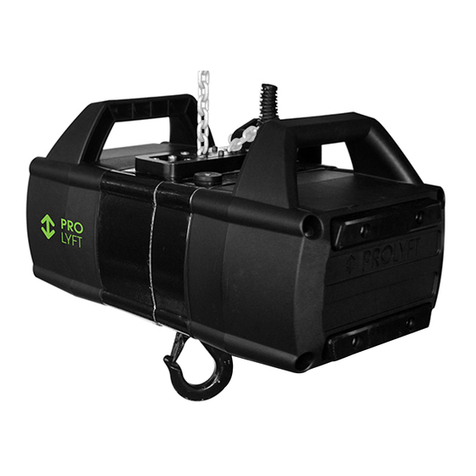
Prolyte
Prolyte PRO LYFT AETOS PAE-250DC Series Operating and maintenance manual

Tractel
Tractel Tralift Operation and maintenance manual
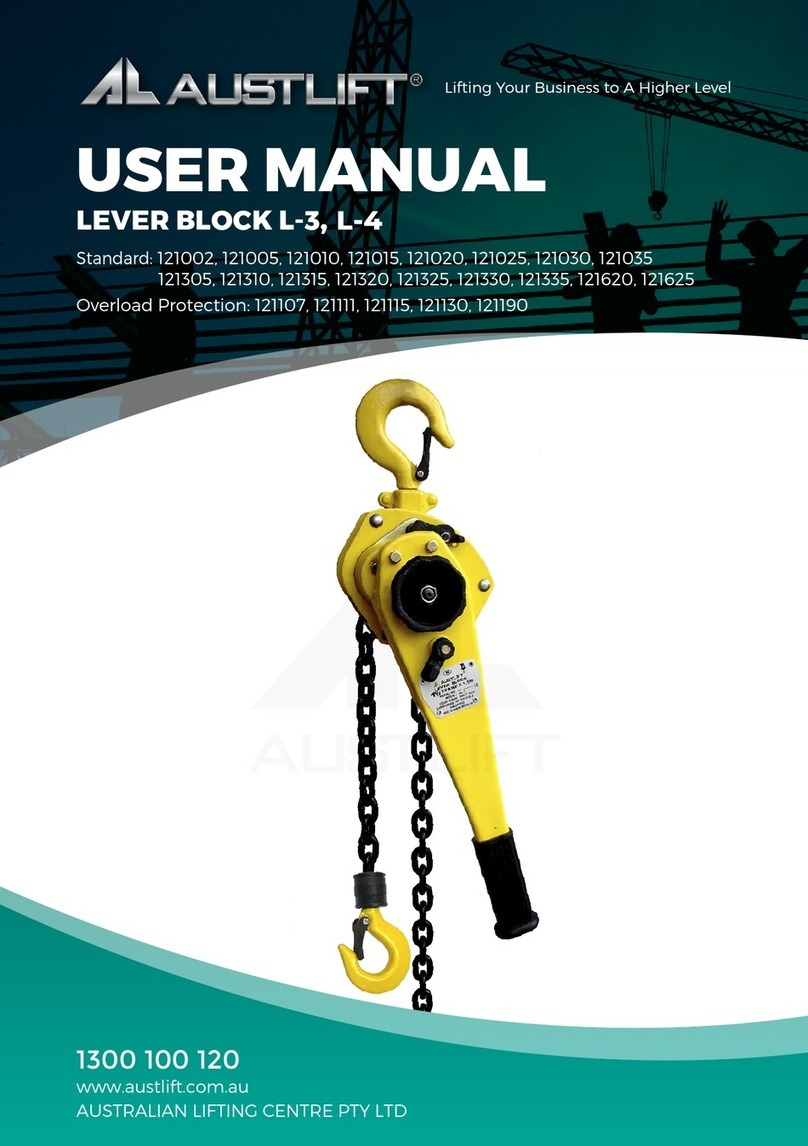
Austlift
Austlift L-3 user manual

Pacific Hoists
Pacific Hoists U-MEGA Series Operations manual & parts list

Steinberg
Steinberg SBS-FZ 1500/2M user manual
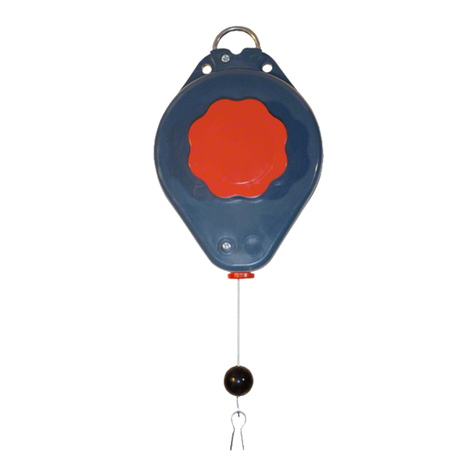
Bosch
Bosch 0 607 950 938 Original operating instructions
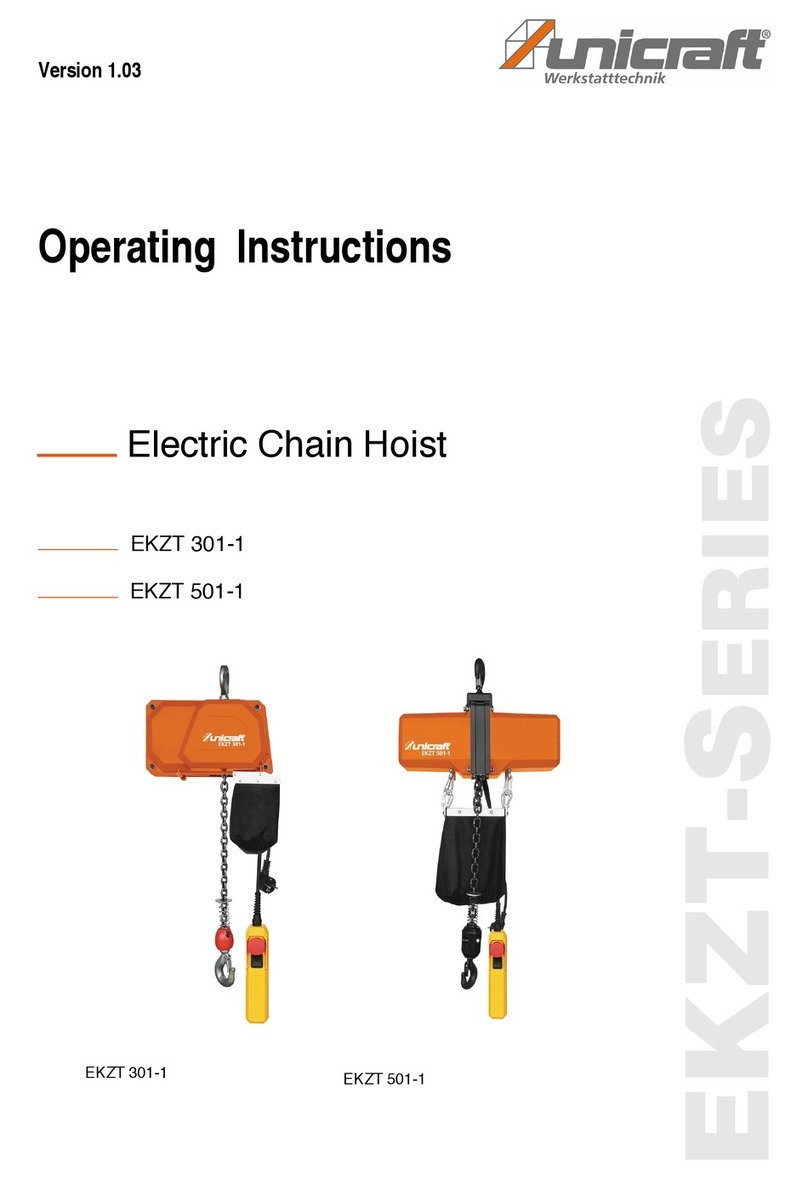
unicraft
unicraft EKZT 301-1 operating instructions
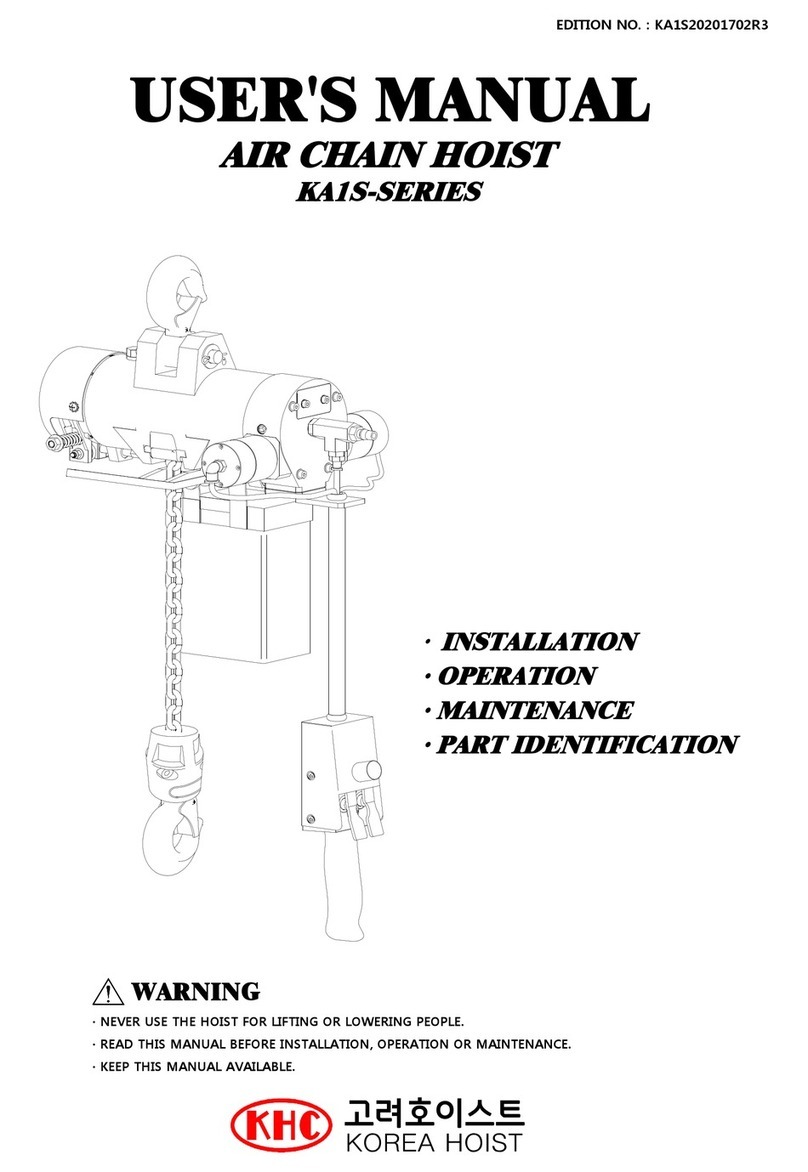
Korea Hoist
Korea Hoist KA1S Series user manual

